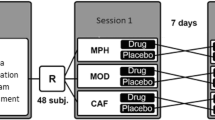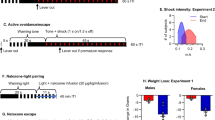Abstract
Low doses of apomorphine can induce biphasic, contralateral circling behaviour in rats having unilateral, 6-hydroxydopamine lesions of the substantia nigra. The present studies examined the extent to which this is linked to the supersensitive state, the possible contribution of apomorphine's actions in the intact striatum, and the extent to which response differentiation might be linked to drug-or non-drug-associated environmental cuing. In the first instance, weekly administration of 0.4 mg/kg SC apomorphine to “normosensitive” rats having electrolytic ablation of one caudate failed to result in biphasic circling, whereas clear biphasic responses developed in supersensitive, 6-hydroxydopamine lesioned animals receiving 0.05 mg/kg SC apomorphine at weekly intervals. In the second instance, 6-hydroxydopamine-lesioned animals exhibiting biphasic responses after three exposures to apomorphine continued to do so after additional electrolytic ablation of the contralateral caudate, indicating a primary role for apomorphine's interaction within the denervated striatum. In studying the possible role of drug- or non-drug-associated environmental cuing effects it was found that repeated exposure of 6-hydroxydopamine-lesioned rats to 0.05 mg/kg SC apomorphine at 2-h intervals failed to elicit biphasic responses, although these were evident when the same animals were tested 1 and 2 weeks later. However, studies combining weekly exposure to the test cages with saline or apomorphine administration failed to reveal a role of drug- or non-drug-associated environmental cuing in response differentiation. The latter findings are supported by those from supplementary studies employing opaque contact lenses, in which lesioned animals continued to respond biphasically to apomorphine when deprived of visual input.
Taken together, the findings show biphasic responsiveness to apomorphine to be entirely a reflection of the drug's interaction with supersensitive dopamine systems.
Similar content being viewed by others
References
Arnt J, Hyttel J (1985) Differential involvement of dopamine D-1 and D-2 receptors in the circling behaviour induced by apomorphine, SK&F 38393, pergolide and LY 171555 in 6-hydroxydopamine-lesioned rats. Psychopharmacology 85:346–352
Beninger RJ (1983) The role of dopamine in locomotor activity and learning. Brain Res Rev 6:173–196
Beninger RJ, Hahn BL (1983) Pimozide blocks establishment but not expression of amphetamine-produced environment-specific conditioning. Science 220:1304–1306
Buerki H-R, Asper H, Ruch W, Zuger PE (1978) Bromocriptine, dihydroergotoxine, d-LSD, CF 25–397 and 29–712: effects on the metabolism of the biogenic amines in the brain of the rat. Psychopharmacology 57:227–237
Chiodo LA, Antelman SM (1980) Repeated tricyclics induce a progressive dopamine autoreceptor subsensitivity independent of daily drug treatment. Nature 287:451–454
Coward DM (1983) Apomorphine-induced biphasic circling behaviour in 6-hydroxydopamine-lesioned rats: a pharmacological kindling phenomenon. Naunyn-Schmiedeberg's Arch Pharmacol 323:49–53
Coward DM (1984) Modification of nigral kainic acid-induced ipsilateral circling behaviour in the rat by neuroleptics and by contralateral caudate ablation. Psychopharmacology 84:526–530
Di Chiara G, Porceddu ML, Vargiu L, Argiolas A, Gessa GL (1976) Evidence for dopamine receptors mediating sedation in the mouse brain. Nature 264:564–567
Herrera-Marschitz M, Ungerstedt U (1985) Effect of the dopamine D-1 antagonist SCH 23390 on rotational behaviour induced by apomorphine and pergolide in 6-hydroxy-dopamine denervated rats. Eur J Pharmacol 109:349–354
Hinson RE, Poulos CX (1983) Sensitisation to the behavioural effects of cocaine: modulation by Pavlovian conditioning. Pharmacol Biochem Behav 15:559–562
Kebabian JW, Calne DB (1979) Multiple receptors for dopamine. Nature 277:93–96
Klawans HL, Margolin DI (1975) Amphetamine-induced dopaminergic hypersensitivity in guinea-pigs. Arch Gen Psychiatry 32:725–732
Koenig JFR, Klippel RA (1963) The rat brain: a stereotaxic atlas of the forebrain and lower parts of the brain stem. Williams and Wilkins, Baltimore
Lace JW, Antelman SM (1983) Cortical beta-adrenergic subsensitivity after desmethylimipramine may depend on the passage of time rather than daily treatment. Brain Res 278:359–361
Ljungberg T (1979) Evidence that time-related changes in apomorphine stimulation determines the behavioural response. Neuropharmacology 18:327–334
Martres MP, Costentin J, Baudry M, Marcias H, Protais P, Schwartz JC (1977) Long-term changes in the sensitivity of pre- and postsynaptic dopamine receptors in mouse striatum as evidenced by behavioural and biochemical studies. Brain Res 136:319–337
Oberlander C, Dumont C, Boissier JR (1980) Time course of apomorphine-induced circling behaviour after striatal dopamine receptor denervation. Eur J Pharmacol 62:107–110
Robinson TE (1984) Behavioural sensitization: Characterisation of enduring changes in rotational behaviour produced by intermittent injections of amphetamine in male and female rats. Psychopharmacology 84:466–475
Ross S, Schnitzer SB (1963) Further support for a placebo effect in the rat. Psychol Rep 13:461–462
Sayers AC, Buerki H-R, Ruch W, Asper H (1975) Neuroleptic-induced hypersensitivity of striatal dopamine receptors in the rat as a model of tardive dyskinesias. Effects of clozapine, haloperiodl, loxapine and chlorpromazine. Psychopharmacologia 41:97–104
Siegel S (1956) Nonparametric statistics for the behavioural sciences. McGraw-Hill, Kogakusha
Strasser S, Dixon AK (1986) Effects of visual and acoustic deprivation on agonistic behaviour of the albino mouse (M. musculus L.). Physiol Behav (In press)
Tilson HA, Rech RH (1973) Conditioned drug effects and absence of tolerance to d-amphetamine induced motor activity. Pharmacol Biochem Behav 1:149–153
Ungerstedt U, Herrera-Marschitz M, Brugue MC (1981) Are apomorphine, bromocriptine and the methylxanthines agonists at the same dopamine receptor? In: Gessa GL, Corsini GU (eds) Apomorphine and other dopaminomimetics, vol 1. Raven Press, New York, pp 85–93
Author information
Authors and Affiliations
Rights and permissions
About this article
Cite this article
Coward, D.M. Apomorphine response plasticity in lesioned rats: Supersensitivity dependency and lack of drug- or non-drug-associated environmental cuing. Psychopharmacology 90, 253–258 (1986). https://doi.org/10.1007/BF00181252
Received:
Revised:
Issue Date:
DOI: https://doi.org/10.1007/BF00181252




